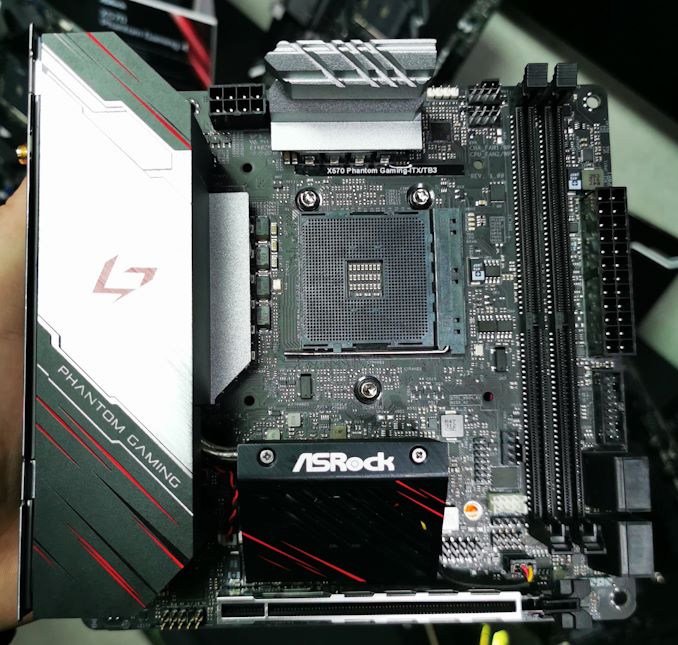The AMD X570 Motherboard Overview: Over 35+ Motherboards Analyzed
by Gavin Bonshor on July 9, 2019 8:00 AM ESTASRock X570 Phantom Gaming-ITX TB3
Well-known in recent times for its impressive mini-ITX motherboard, the ASRock X570 Phantom Gaming-ITX TB3 includes a very solid feature set. The ASRock X570 Phantom Gaming-ITX TB3 joins a small handful of small form factor X570 models at launch but looks to stand-out from the crowd with a major feature; a Thunderbolt 3 Type-C connector on the rear panel.

Following in line with the rest of its premium X570 product stack, ASRock has equipped the board with a hefty looking 10-phase power delivery, and official support for DDR4-4533 memory across two available slots with a total capacity of up to 64 GB. A single full-length PCIe 4.0 x16 slot is located at the bottom of the board, with a single PCIe 4.0 x4 M.2 slot, and just four SATA ports. The networking is handled by an Intel Gigabit LAN port, while the Wi-Fi 6 802.11ax wireless interface is controlled by the Killer AX1650 interface with support for BT 5 devices.

On the rear panel alongside the single Thunderbolt 3 Type-C connector which is the highlight of the board, the ASRock X570 Phantom Gaming-ITX TB3 also includes two USB 3.1 G2 Type-A and two USB 3.1 G1 Type-A ports. This is contradictive on the official specifications that were given to us at Computex which stated this model has two USB 3.1 G2 Type-A ports on the rear, as well as two USB 2.0 ports which also seem to be missing from the rear panel. On the display model at Computex, there is a clear CMOS button, a DisplayPort input and HDMI video output, with a PS/2 combo port, and five 3.5 mm color coded audio jacks with a S/PDIF optical output due to the use of a Realtek ALC1220 HD audio codec.
The ASRock X570 Phantom Gaming-ITX TB3 mini-ITX motherboard looks to stand out from other brands mini-ITX offerings with the Thunderbolt 3 which has been a mainstay of its desktop-focused small form factor models of recent times. A solid looking 10-phase power delivery similar to that of the ASRock Z390 Phantom Gaming-ITX/ac model we reviewed makes this even more appealing to users looking to push out the overclocks on the new Ryzen 3000 series processors. The X570 Phantom Gaming-ITX TB3 has an MSRP of $300, which is by no means cheap in comparison to its other mini-ITX models of late.










225 Comments
View All Comments
abufrejoval - Tuesday, July 9, 2019 - link
It's amazing how quickly you run out of PCIe lanes, when you don't have switches to multiplex and translate between PCIe revisions and lanes (e.g. PCIe v4 x2 <-> PCIe v2 x8).I find myself using USB 3.x NBase-T NICs and NVMe adapters, simply because they *do* switch.
Bensam123 - Tuesday, July 9, 2019 - link
Maybe a bit more depth on the power delivery page. I have absolutely no idea how to go about parsing what's there. More chokes is better? What denotes a power phase?A5 - Tuesday, July 9, 2019 - link
+1. Some analysis of that information would be helpful.MrSpadge - Tuesday, July 9, 2019 - link
+1bunkle - Wednesday, July 10, 2019 - link
The controller column includes the total number of phases supported split between CPU cores and SoC e.g. (6+1) = 6 CPU phase and 1 SoC phase. More is *usually* better but has diminishing returns regarding tighter and tighter voltage regulation. Some controllers are better than others (can operate at high frequency e.g. 500KHz v 1000KHz, include other features to improve performance) mitigating the need for more phases.Each phase is a buck converter comprised of a low/high side MOSFET (can be integrated in a single package) and choke. Some controllers can support doubling up the PWM signal to driver more MOSFETs. Doublers can also be added as discrete components if not built into the controller.
Current rating of the MOSFET (e.g. Sic639=40A IR3555=60A) indicates the total power deliverable. MOSFETs are not 100% efficient and vary in efficiency. The more current they provide the hotter they get and the less efficient they become, with better MOSFETs producing less heat for a given current. Thus using doubles can improve temperatures and efficiency without the benefits of the tighter voltage tolerance that *real* phases provide.
Hope that’s helpful!
bunkle - Wednesday, July 10, 2019 - link
A lot more detailed explanation: https://en.wikichip.org/wiki/voltage_regulator_mod...bug77 - Tuesday, July 9, 2019 - link
The description for AsRock X570(M) Pro4 says "5 jack + 1 SPDIF". Unfortunately, those boards lack SPDIF and only come with 3 jacks ;)Smell This - Tuesday, July 9, 2019 - link
I'm thinking the *ASRock Thunderbolt AIC* ...https://thunderbolttechnology.net/product/asrock-t...
would cover all your TBT peripheral needs, including optical.
DanNeely - Tuesday, July 9, 2019 - link
Do X570 boards still need an extra chip per USB port to support USB-C reversibility?The additional expense and needed PCB space were cited as among the reasons why earlier generation boards (IIRC both Intel and AMD) almost never had more than 1 C port; but it was never clear to me if that was an inherent implementation penalty for the C port or an artifact of Intel's tech stack being stalled out and AMD outsourcing to ASMedia which built the chipsets on an ancient (55nm) platform.
DigitalFreak - Tuesday, July 9, 2019 - link
Gavin - X370 and X470 only supported PCIe 2.0. The connection between the CPU and chipset was 3.0, but all the ports on the chipset were 2.0.